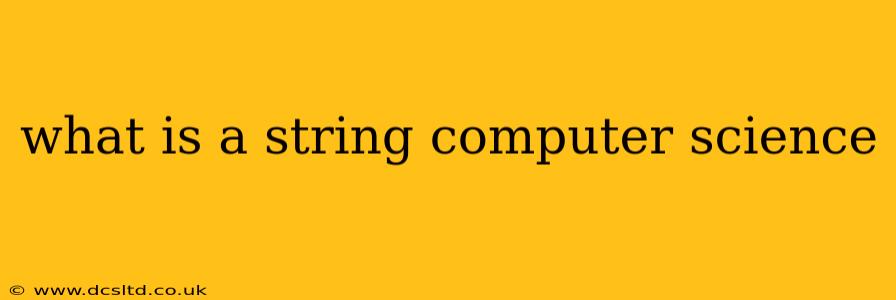In computer science, a string is a sequence of characters. These characters can be letters, numbers, symbols, or whitespace (spaces, tabs, newlines). Strings are a fundamental data type used extensively in programming to represent and manipulate textual data. Think of them as a way to store and work with text within a program.
Strings are typically enclosed in quotation marks (single ' or double "), depending on the programming language. For example, in Python:
my_string = "Hello, world!"
or in JavaScript:
let myString = 'This is a string.';
What are Strings Used For?
Strings are incredibly versatile and form the backbone of many applications. Here are some common uses:
- Text Processing: Analyzing, manipulating, and transforming text data is a primary function of strings. This includes tasks like searching, replacing, splitting, and concatenating text.
- Data Representation: Strings can store names, addresses, product descriptions, and any other textual information.
- User Input and Output: Most interactions with users involve strings, whether receiving input from a keyboard or displaying output on a screen.
- Web Development: Strings are crucial for building websites, handling user interactions, and managing data exchanged between clients and servers.
- Natural Language Processing (NLP): NLP algorithms heavily rely on string manipulation to analyze and understand human language.
How are Strings Stored?
Strings are stored in memory as arrays of characters. Each character is assigned a numerical value according to a character encoding scheme, such as ASCII or Unicode. The computer uses these numerical values to represent and manipulate the string.
Common String Operations
Most programming languages provide a rich set of built-in functions for working with strings. These operations include:
- Concatenation: Joining two or more strings together (e.g., "Hello" + " " + "world!").
- Substrings: Extracting a portion of a string.
- Search and Replace: Finding specific characters or patterns within a string and replacing them with others.
- Length: Determining the number of characters in a string.
- Comparison: Comparing two strings to determine if they are equal or which one comes before the other alphabetically.
- Case Conversion: Changing the case of characters (e.g., converting to uppercase or lowercase).
What is the Difference Between a String and a Character?
A character is a single element within a string. A string is a collection of one or more characters. For example, in the string "apple", 'a', 'p', 'p', 'l', and 'e' are individual characters.
How are Strings Implemented in Different Programming Languages?
While the basic concept of a string remains consistent, the implementation details can vary between programming languages. Some languages treat strings as immutable (their values cannot be changed after creation), while others allow for mutable strings. The specific functions and methods available for string manipulation also differ.
Are Strings Efficient?
String manipulation can be computationally expensive, especially for large strings or complex operations. Efficient algorithms and data structures are often employed to optimize string processing.
This detailed explanation provides a comprehensive understanding of strings in computer science, covering their definition, applications, underlying implementation, and common operations. By understanding these fundamental concepts, developers can effectively utilize strings to build robust and efficient software applications.
